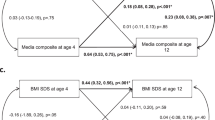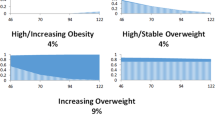Abstract
Objective:
To investigate ecological correlates of the development of overweight in a multisite study sample of children followed from age 2 to 12.
Design:
Longitudinal examination of covariates of overweight status throughout childhood, with covariates drawn from three ecological levels: sociocultural or demographic, quality of the child's home environment, and proximal child experience that could directly affect the balance between energy intake and energy expenditure.
Subjects:
A total of 960 children participating in a long-term longitudinal study provided growth data at least once; 653 of the children had complete data on covariates.
Measurements:
Height and weight measured seven times between ages 2 and 12 were converted to a body mass index (BMI) and entered into a latent transition analysis to identify patterns of overweight across childhood. Ecological correlates measured longitudinally included demographic characteristics obtained by maternal report, home environment quality obtained by observation and maternal report, and proximal child experience factors obtained by observation, maternal report and child report.
Results:
Four patterns of overweight were found: never overweight, overweight beginning at preschool age, overweight beginning in elementary school, and return to normal weight after being overweight at preschool age. The weight status groups differed on home environment quality and proximal child experience factors but not on demographics. Children overweight at preschool had less sensitive mothers than never overweight children. Children overweight at school age had fewer opportunities for productive activity at home than did never overweight children. School-age overweight children also watched the most TV after school. Multivariate logistic regression analyses further indicated the significance to children's weight status of proximal child experience variables. Less physically active children and those who watched more television after school were more likely to become overweight. Results did not vary by child sex.
Conclusion:
The results support the idea that childhood overweight is multiply determined. The one potentially important and changeable factor identified as a target for intervention centers on how children spend their time, especially their after-school time. Children who are more physically active and spend less time watching TV after school are less likely to become overweight by age 12.
This is a preview of subscription content, access via your institution
Access options
Subscribe to this journal
Receive 12 print issues and online access
$259.00 per year
only $21.58 per issue
Buy this article
- Purchase on Springer Link
- Instant access to full article PDF
Prices may be subject to local taxes which are calculated during checkout
Similar content being viewed by others

References
Daniels SR, Arnett DK, Eckel RH, Gidding SS, Hayman LL, Kumanyika S et al. Overweight in children and adolescents: pathophysiology, consequences, prevention, and treatment. Circulation 2005; 111: 1999–2012.
Kaplan JP, Liverman CT, Kraak VI (eds). Preventing Childhood Obesity: Health in the Balance. The National Academies Press: Washington, DC, 2005.
Anderson P, Butcher K . Childhood obesity trends and potential causes. Future Child 2006; 16: 19–45.
Krishnamoorthy JS, Hart C, Jalalian E . The epidemic of childhood obesity: review of research and implications for public policy. Soc Policy Rep 2006; 14: 3–17.
Kalb C, Springen K . Pump up the family. Newsweek 2005; 145: 62–65.
Wallis C . Critical condition: America's obesity crisis. Time 2004; 163: 79–85.
French SA, Lin B-H, Guthrie J . National trends in soft drink consumption among children and adolescents age 6 to 17 years: prevalence, amounts, and sources, 1977/1978 to 1994/1998. J Am Diet Assoc 2003; 103: 1326–1331.
French SA, Story M, Jeffery RW . Environmental influences on eating and physical activity. Annu Rev Public Health 2001; 22: 309–335.
Beldon Russonello & Stewart Research and Communications. Americans' attitudes toward walking and creating better walking communities. Surface Transportation Policy Project Report. B Russonello & Stewart Research and Communications: Washington, 2003 Available at: http://www.transact.org/report.asp?id=205/ Retrieved November 24, 2006.
Berkey CS, Rockett HRH, Field AE, Gillman MW, Frazier AL, Camargo CA et al. Activity, dietary intake and weight changes in a longitudinal study of preadolescent and adolescent boys and girls. Pediatrics 2000; 105: e56.
O'Loughlin J, Gray-Donald K, Paradis G, Meshefedjian G . One- and two-year predictors of excess weight gain among elementary schoolchildren in multiethnic, low-income, inner city neighborhoods. Am J Epidemiol 2000; 152: 739–746.
Trost SG, Kerr LM, Ward DS, Pate RR . Physical activity and determinants of physical activity in obese and non-obese children. Int J Obes. Relat Metab Disord 2001; 25: 822–829.
Strauss RS, Pollack HA . Epidemic increase in childhood overweight, 1986–1998. JAMA 2001; 286: 2845–2848.
Lissau I, Sorensen TI . Parental neglect during childhood and increased risk of obesity in young adulthood. Lancet 1994; 343: 324–327.
Sorensen I, Sorensen TI . Prospective study of the influence of social factors in childhood on risk of overweight in young adulthood. Int J Obes Relat Metab Disord 1992; 16: 169–175.
Strauss RS, Knight J . Influence of the home environment on the development of obesity in children. Pediatrics 1999; 103: e85.
Kimm SYS, Obarzanek E . Childhood obesity: a new pandemic of the new millennium. Pediatrics 2002; 110: 1003–1106.
Ogden CL, Flegal KM, Carroll MD, Johnson CL . Prevalence and trends in overweight among US children and adolescents, 1999–2000. JAMA 2002; 288: 1728–1732.
Kuczmarski RJ, Ogden CL, Guo SS, Grummer-Strawn LM, Flegal KM, Mei Z et al. 2000 CDC growth charts for the United States: Methods and development. Vital Health Stat 11 2002; 246: 1–190.
Sallis JR, Owen N . Ecological models of health behavior. In: Glanz K, Rimmer BK, Lewis FM (eds). Health Behavior and Health Education: Theory, Research, and Practice 3rd ed Jossey-Bass: San Francisco, 2002. pp 462–484.
Whitaker RC, Pepe MS, Wright JA, Seidel KD, Dietz WH . Early adiposity rebound and the risk of adult obesity. Pediatrics 1998; 101: e5.
Nader PR, O'Brien M, Houts R, Bradley RH, Belsky J, Crosnoe R et al. Identifying risk for obesity in early childhood. Pediatrics 2006; 118: e594–e601.
NICHD Early Child Care Research Network. Child care and child development: the NICHD Study of Early Child Care. In Friedman SL, Haywood HC (eds). Developmental follow-up: concepts, domains, methods. Academic Press, San Diego, 1994, pp 377–396.
Radloff LS . The CES-D Scale: a self-report depression scale for research in the general population. Appl Psychol Meas 1977; 1: 385–401.
Caldwell B, Bradley RH . Home Observation for Measurement of the Environment. Center for Research on Teaching and Learning: Little Rock, AR, 1984.
NICHD Early Child Care Research Network. Child care and mother–child interaction in the first three years of life. Dev Psychol 1999; 35: 1399–1413.
Winer B . Statistical Principles in Experimental Design 2nd ed McGraw-Hill: New York, 1971.
Shumow L, Vandell DL, Posner J . Harsh, firm, and permissive parenting in low-income families: relations to children's academic achievement and behavioral adjustment. J Fam Iss 1998; 19: 483–507.
Rothbart M, Ahadi S, Hershey K . Temperament and social behavior in childhood. Merrill-Palmer Quart 1994; 40: 21–39.
Trost SG, Pate RR, Freedson PS, Sallis JF, Taylor WC . Using objective physical activity measures with youth: how many days of monitoring are needed? Med Sci Sport Exerc 2000; 32: 426–431.
Posner JK, Vandell DL . Low income children's after-school care: are there beneficial effects of after-school programs? Child Dev 1994; 65: 440–456.
Greenberg MT, Lengua LJ, Coie JD, Pinderhughes EE, Bierman K, Dodge KA et al. Predicting developmental outcomes at school entry using a multiple-risk model: four American communities. Dev Psychol 1999; 35: 403–417.
Lanza S, Flaherty BP, Collins LM . Latent class and latent transition analysis. In: Schinka JA, Velicer WF (eds). Handbook of Psychology, Vol 2, Research Methods in Psychology. Hoboken, NJ: Wiley, 2003; 663–685.
Kaplan D . An overview of Markov chain methods for the study of stage-sequential developmental processes Obtained 15 Jan 2007. from http://www.statmodel.com/download/dKaplan.MarkovModels.pdf.
Ritchie LD, Weld G, Styne D, Gerstein DE, Crawford PB . Family environment and pediatric overweight: what is a parent to do? J Am Diet Assoc 2005; 105: S70–S79.
Davison KK, Birch LL . Childhood overweight: a contextual model and recommendations for future research. Obes Rev 2001; 2: 159–171.
Calderon KS, Yocha CB, Shaffer SD . Obesity-related cardiovascular risk factors: intervention recommendations to decrease adolescent obesity. J Pediatr Nurs 2005; 20: 3–14.
Sothern MS . Obesity prevention in children: physical activity and nutrition. Nutrition 2004; 20: 704–708.
Rhee KE, Lumeng JC, Appugliese DP, Kaciroti N, Bradley RH . Parenting styles and overweight status in first grade. Pediatrics 2006; 117: 2047–2054.
Must A, Anderson SE . Body mass index in children and adolescents: considerations for population-based applications. Int J Obes Relat Metab Disord 2006; 30: 590–594.
Acknowledgements
The NICHD Study of Early Child Care and Youth Development was directed by a Steering Committee and supported by the National Institute of Child Health and Human Development (NICHD) through a cooperative agreement (U10), which calls for scientific collaboration between the grantees and the NICHD staff. In addition to the named authors, the following members of the NICHD Early Child Care Research Network contributed to this manuscript:
Cathryn Booth-LaForce, University of Washington; Celia Brownell, University of Pittsburgh; Margaret Burchinal, University of North Carolina, Chapel Hill; Susan B Campbell, University of Pittsburgh; K Alison Clarke-Stewart, University of California, Irvine; Bonnie Knoke, Research Triangle Institute; Kathleen McCartney, Harvard University; Margaret T Owen, University of Texas, Dallas; Ross Parke, University of California, Riverside; Susan Spieker, University of Washington; Deborah Vandell, University of California, Irvine; and Marsha Weinraub, Temple University. We thank our study coordinators and research assistants who collected the data and all the children and families who participated in the study.
Author information
Authors and Affiliations
Consortia
Corresponding author
Rights and permissions
About this article
Cite this article
O'Brien, M., Nader, P., Houts, R. et al. The ecology of childhood overweight: a 12-year longitudinal analysis. Int J Obes 31, 1469–1478 (2007). https://doi.org/10.1038/sj.ijo.0803611
Received:
Revised:
Accepted:
Published:
Issue Date:
DOI: https://doi.org/10.1038/sj.ijo.0803611
Keywords
This article is cited by
-
Clinical heterogeneity of sleep quality, emotional and behavioral characteristics, and eating habits in adolescents with obesity: A cluster analysis
European Journal of Pediatrics (2024)
-
Maternal stress and depressive symptoms and adolescents’ body mass index: a prospective study
BMC Public Health (2021)
-
Does obesity persist from childhood to adolescence? A 4-year prospective cohort study of chinese students in Hong Kong
BMC Pediatrics (2021)
-
Study protocol for a cluster randomized controlled trial to test “¡Míranos! Look at Us, We Are Healthy!” – an early childhood obesity prevention program
BMC Pediatrics (2019)
-
Migration background and childhood overweight in the Hannover Region in 2010–2014: a population-based secondary data analysis of school entry examinations
European Journal of Pediatrics (2018)


